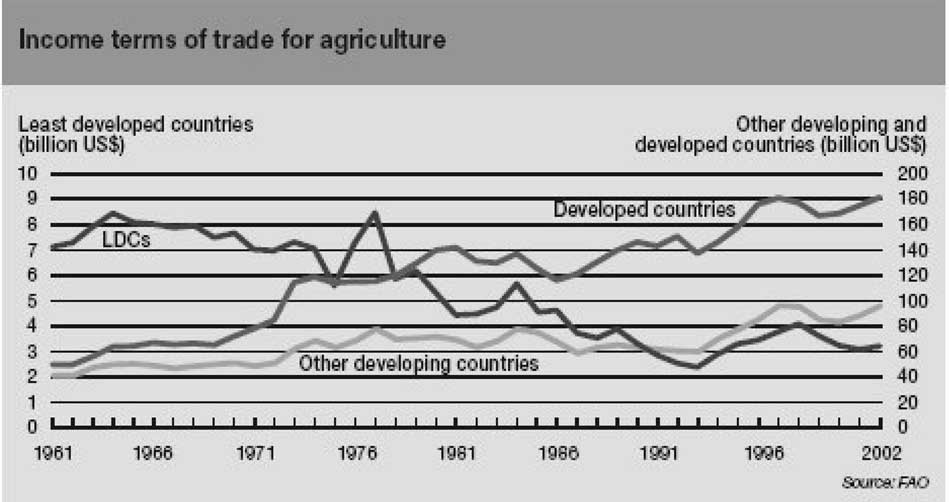| Previous | Return to table of contents | Search Reports | Next |
| « Back to weltagrarbericht.de | ||
Outlook on Agricultural Changes and Its Drivers | 267

Figure 4-7. Income terms of trade for agriculture. Source: FAO, 2004b.
• Most models have not had sufficient resolution to analyze the impacts of reforms on small-scale and subsistence farmers, and other poor households (Gulati and Narayanan, 2002; Tokarick, 2002; Beierle and Diaz-Bonilla, 2003; Hertel and Winters, 2005). 4.3.2.4 Agricultural investments |
|
Foreign Direct Investment (FDI) is an important source of capital flows for development. FDI for agriculture is generally lower than that of other sectors. In countries such as Vietnam, FDI in agriculture and rural areas is declining similar to other regions; IBRD/IDA commitments to the agricultural sector are also declining (Binh, 2004). 4.3.2.5 Implications forAKST Higher incomes will also mean more expensive farm labor; this can be addressed through increased mechanization, and clustering of small farms, whenever applicable, for more efficient management (assuming sufficient access to capital and/or demand for labour in other economic sectors). Due to higher opportunity costs of time, supermarkets will be in high demand. In addition, food quality assurance will need to be met through certification, labeling, and appropriate packaging. These conditions are currently deficient in most developing countries. |
|||||||
Region/Country |
Irrigation |
Rural Roads |
Education |
Clean Water |
National Agricultural Research |
Total Investments |
||
Billions of US Dollars |
||||||||
Latin America |
44.8 |
36.7 |
12.1 |
9.8 |
37 |
140.4 |
||
West Asia/North Africa |
17.9 |
7.3 |
21.5 |
8.5 |
25.3 |
80.5 |
||
Sub-Saharan Africa |
28.1 |
37.9 |
15.7 |
17.3 |
8 |
106.9 |
||
South Asia |
61.3 |
27.4 |
14.5 |
27 |
18 |
148.2 |
||
India |
42.5 |
23.5 |
10.5 |
18.4 |
15.6 |
110.5 |
||
Southeast Asia |
18.6 |
3.9 |
6.8 |
9.4 |
14.1 |
52.6 |
||
China |
3.2 |
6.8 |
2.4 |
14.4 |
14.6 |
41.4 |
||
Developing countries |
174.6 |
120.3 |
75.9 |
86.5 |
121.7 |
578.9 |
||
| Previous | Return to table of contents | Search Reports | Next |
| « Back to weltagrarbericht.de | ||